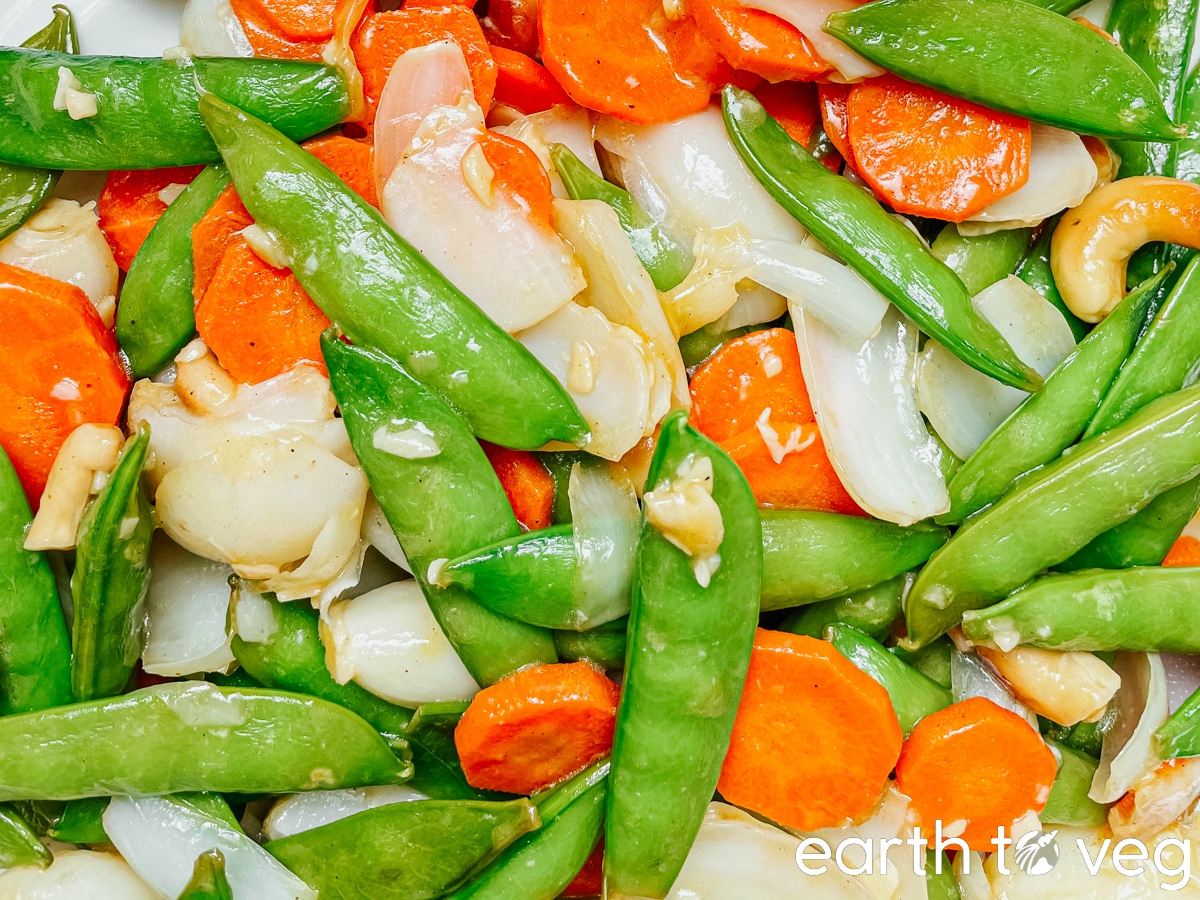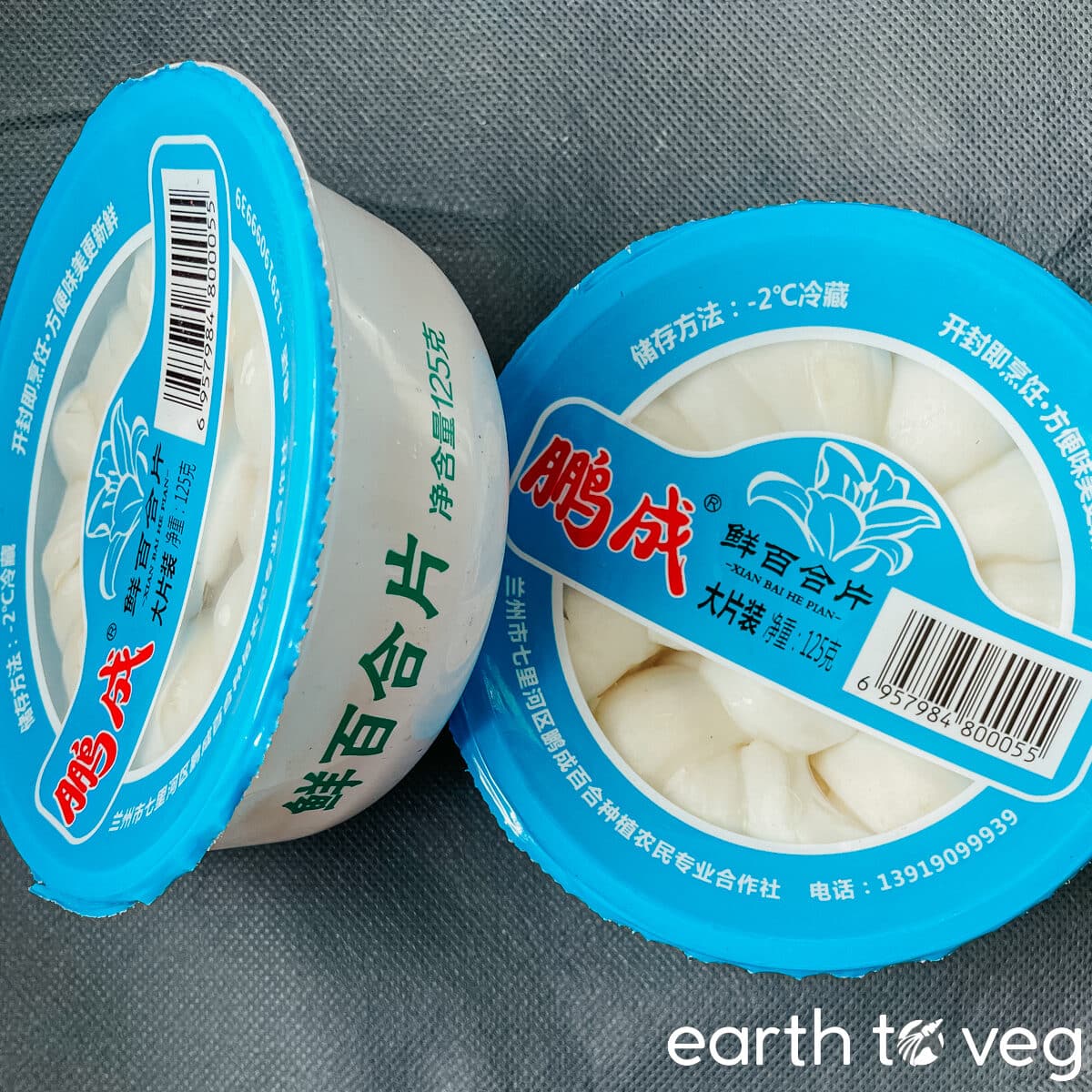Did you know many flowers and their roots are edible? Lily bulbs (百合) are native to China and are a popular Asian ingredient, particularly in soups or stir fries. Here’s a simple way to prepare them, in a Lily Bulb Stir Fry coated with a delicious garlic glaze, that brings out the unique flavour of these bulbs.

Chinese Glaze
The garlic glaze used in this recipe is one of the classic Chinese stir fry sauces. It’s a great all-purpose sauce for stir-frying veggies. Feel free to use it on any other vegetables you have lying around, especially those that have a bit of crunch.

Types of Lily Bulbs
There are three “formats” of lily bulbs and you should be able to find at least one in a larger Asian supermarket:
Whole: I haven’t seen whole fresh lily bulbs for sale anywhere here in my city. (Umm maybe at a gardening center?? jk!) If you are able to find whole lily bulbs for this recipe, you can refer to this video for how to clean and prepare them.
Prepackaged: The lily bulbs I can buy are the prepackaged ones that have already been separated and washed so you can skip the tedious process of cleaning them. I simply give them a rinse and they’re ready to go.


Dried: These may be the most accessible option, however they’re also my least favourite because they tend to be sold for medicinal purposes, and taste more bitter than the fresh varieties intended for cooking. They can be rehydrated as follows: 1/2 cup (30 g) of dried lily bulbs becomes 3/4 cups (70 g) after soaking in water overnight.


Step-by-Step Process

Step 1: Bring water to a boil in a wok. Add the lily bulbs, snow peas, and carrot. Blanch for two minutes, then drain and run under cold water.
Step 2: Return the wok to high heat. Once residual water has evaporated, add the oil followed by the cashews and ginger.

Step 3: Stir fry briefly, then add the blanched veggies. Turn the heat down to medium. Meanwhile, mix together the ingredients for garlic glaze.
Step 4: Pour glaze over the vegetables. Continue stirring until the glaze has thickened, then remove from heat. Discard the ginger slices and serve.
Recipe FAQs
Lily bulbs taste a little similar to a softer, starchier water chestnut. It has a lightly nutty, flowery taste which many people enjoy, but I actually find it a bit off-putting. That’s why I prefer cooking it with a garlic glaze as in this recipe because I can enjoy that starchy texture with only a hint of the “lily fragrance.” Lily bulbs aren’t overwhelmingly flavorful but they have a unique, delicate taste that can absorb and complement other flavors well.
To cook lily bulbs by stir-frying, first peel and separate the individual layers, then blanch in boiling water and rinse. Heat oil in a wok or frying pan over medium-high heat, add nuts, and stir until fragrant. Add the lily bulbs and other vegetables like snow peas and carrots, stir-frying until they are tender but still crisp. Season with garlic glaze or soy sauce, salt, and pepper to taste.
Lily bulbs are a versatile ingredient commonly used in Asian cuisine, offering a subtly sweet, starchy, and nutty flavor with a crisp texture. They can be stir-fried with vegetables and proteins, added to soups and stews for texture, thinly sliced into salads for a crunchy element, or steamed as a simple side dish. Lily bulbs can also be braised with meats and vegetables, and in some traditional recipes, they even make their way into desserts.
If you are using dried lily bulbs, yes, you need to soak them to rehydrate them and discard the bitter soaking water. However, for stir fry recipes like this one, I don’t recommend using dried lily bulbs because even after soaking, they are still very bitter. Fresh lily bulbs have a fragrant, slightly sweet taste and fare much better in stir fries than their dried counterparts. Save dried lily bulbs for soups.
As far as I know, only lily bulbs are used in Chinese cooking. I know that tulip bulbs, for example, can be poisonous. So don’t try to sub other bulbs for lily bulbs; better to leave them out entirely and still end up with a nice snow pea and carrot stir fry.
More Asian Recipes

Recipe Card

Lily Bulb Stir Fry
Use Imperial/Metric buttons below to toggle between volume vs weight measurements. I recommend weighing out your ingredients for best results.
Ingredients
Stir Fry
- 1 tbsp grapeseed oil or other high-smoke point oil
- 2 tbsp cashews see Note 1
- 1 inch fresh ginger, sliced into coins
- ¾ cup lily bulbs see Note 2
- 1½ cups snow peas or snap peas
- 1 medium carrot, peeled and sliced on a bias
Garlic Glaze
- 3 cloves garlic, minced
- 1 tbsp shaoxing wine or mirin
- 1 tbsp water
- ½ tsp fine salt or 3/4 tsp kosher salt
- ½ tsp ground white pepper *can sub black pepper
- 1 scant tsp cornstarch
Instructions
- Mix together the ingredients for garlic glaze and set aside until step 5.
- Bring 3 cups of water to a boil in a wok. Add the lily bulbs, snow peas, and carrot. Blanch for two minutes, then drain and run under cold water. Set aside until step 4.
- Return the wok to high heat, and add the oil followed by the cashews and ginger.
- Stir fry for 15 seconds, then add the blanched veggies. Turn the heat down to medium and stir fry until any excess water has been evaporated (2–3 minutes).
- Give the garlic glaze a quick mix to stir up any cornstarch that has settled, then pour it onto the vegetables. Continue stirring until the glaze has thickened, then remove from heat.
- Discard the ginger slices and serve.
Notes
- Peanut is an okay substitute in place of cashew. Sometimes I like to use a mix of both.
- I typically buy the prepackaged fresh bulbs for this recipe but you can also use whole bulbs. I don’t recommend using dried lily bulbs as they can be bitter. See the “Types of Lily Bulbs” section above for more info.
